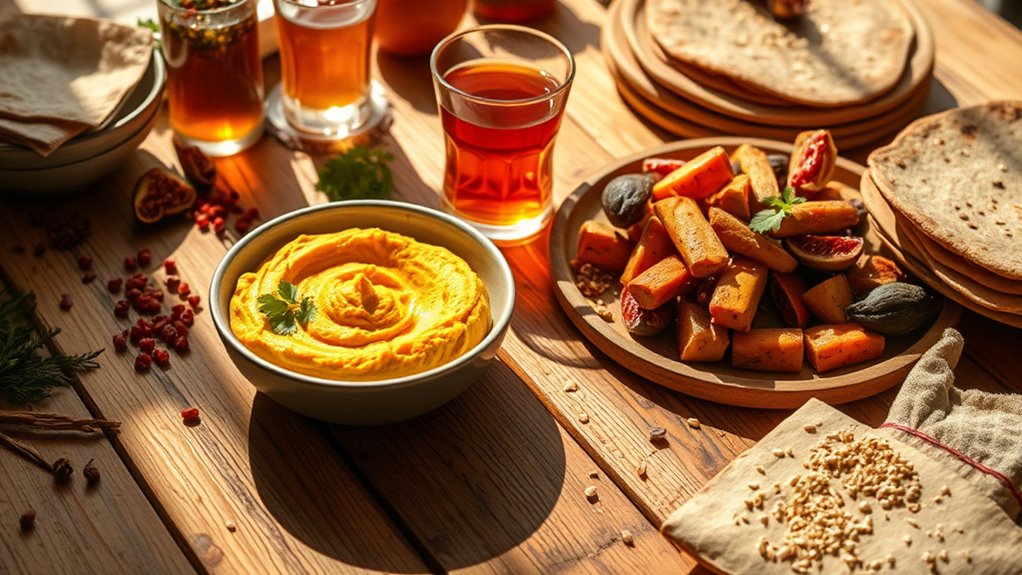Discover how to enjoy bohemian cuisine with easy, healthy recipes blended with global flavors. You can embrace hearty Czech dishes like slow-cooked stews, enriched with regional spices such as paprika and caraway, while adding international twists like cumin or turmeric. Whip up vibrant salads, wholesome baked goods, and vegetable-based meals that celebrate regional ingredients and modern techniques. Keep exploring for tips and ideas on creating delicious, nutritious dishes inspired by bohemian heritage and world cuisines.
Key Takeaways
- Combine traditional Czech ingredients like paprika and caraway with global spices for flavorful, healthy fusion dishes.
- Use slow-cooking and baking techniques to preserve nutrients while creating hearty, comforting recipes.
- Incorporate regional ingredients and seasonal vegetables for vibrant, nutritious, and authentic Bohemian-inspired meals.
- Modernize recipes with international grains, herbs, and superfoods to add depth and wellness benefits.
- Present dishes creatively through layered, deconstructed, or artistic plating styles blending tradition with modern aesthetics.
Embracing the Heartiness of Traditional Czech Dishes
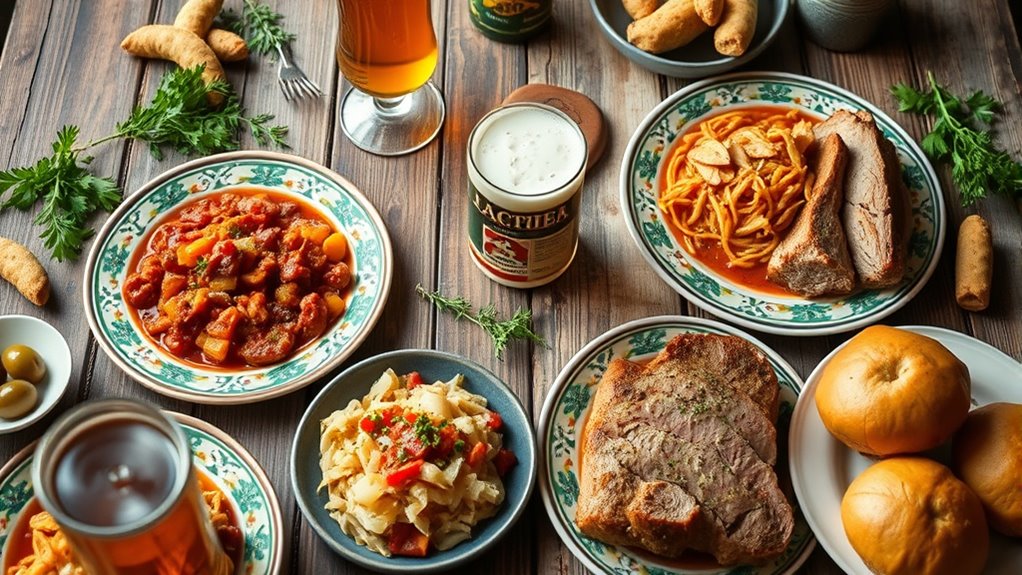
Traditional Czech dishes embody heartiness and comfort, with slow-cooked flavors that create rich, satisfying meals. You’ll notice how traditional Czech dishes highlight hearty flavors achieved through simple ingredients like paprika, caraway seeds, and fresh herbs. These recipes emphasize long, gentle cooking methods that develop deep, robust tastes, making each bite filling and memorable. Dishes like goulash and paprika pork showcase how uncomplicated ingredients combine to produce complex, flavorful results. Bread plays a vital role, with caraway bread and dumplings serving as essential accompaniments. This approach reflects Bohemia’s culinary tradition of balancing nutrition and flavor while honoring time-honored techniques. Additionally, the use of natural ingredients demonstrates how traditional methods preserve the authenticity and nutritional value of each dish. Embracing culinary traditions can bring a sense of cultural connection to your cooking. As you explore these meals, you’ll appreciate how straightforward ingredients come together to create comforting, hearty dishes rooted in cultural heritage.
Incorporating Global Flavors Into Bohemian Recipes
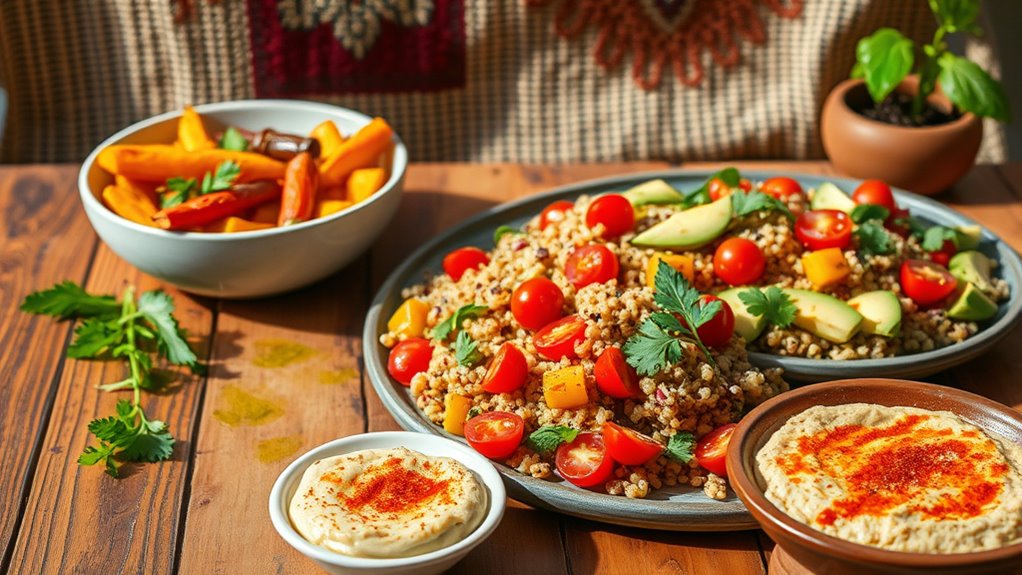
You can easily blend global flavors into Bohemian recipes by adding spices like cumin or chili powder to traditional stews, giving them a new dimension. Incorporating ingredients such as coconut milk or soy sauce can introduce Asian influences that deepen hearty dishes. Experimenting with herbs like oregano or basil in bread and meat recipes brings a fresh, regional twist to classic favorites. Paying attention to home modifications can also enhance the overall dining experience, making it safer and more accessible for the elderly. Additionally, using self watering plant pots in your garden or kitchen space can ensure your herbs and plants stay healthy and vibrant, complementing your culinary creations. Incorporating sustainable practices into your cooking and gardening routines can further promote eco-friendly living while enjoying flavorful, healthful meals. Being mindful of digital literacy can help you access a broader range of recipes and culinary techniques online, expanding your global culinary repertoire. Utilizing aesthetic dinnerware and serveware can further elevate your presentation and make your meals more inviting.
Regional Ingredient Fusion
By blending global spices like paprika, cumin, and turmeric into Bohemian dishes, you can elevate flavors while honoring regional roots. This regional ingredient fusion enriches Bohemian cuisine, creating a vibrant mix of traditional and international elements. Incorporating ingredients like Mediterranean olives or Middle Eastern herbs into classic bread recipes introduces new textures and regional tastes that excite the palate. Using international grains such as quinoa or bulgur alongside traditional ingredients like caraway seeds broadens both nutritional value and cultural diversity. Fusion techniques like adding Asian soy sauce or Thai chili to Czech goulash add a contemporary twist without overshadowing the dish’s heritage. This approach allows you to craft innovative, healthy recipes that celebrate the rich tapestry of global flavors within Bohemian cuisine. Additionally, embracing a vibrational mindset can help you attract inspiration and positive energy during your culinary creations. Cultivating resilience in your cooking process can empower you to experiment confidently with new flavors and techniques. Incorporating cultural awareness into your cooking not only enhances flavor profiles but also deepens your appreciation for diverse culinary traditions. Exploring holistic health benefits associated with various spices and ingredients can further enhance the healthfulness of your dishes. For example, integrating nutrient retention strategies ensures that the health benefits of ingredients like baked kale are preserved during preparation.
Cooking With International Spices
Incorporating international spices into Bohemian recipes opens up a world of bold, new flavors that complement and enhance regional ingredients. Using spices like paprika, caraway, and dill adds authentic regional flavor and depth, while global spices such as cumin, turmeric, or five-spice bring a modern fusion to traditional dishes. Balancing warm spices like cinnamon and cloves can create a unique blend of European and Middle Eastern flavors, enriching hearty stews like goulash. Experimenting with chili flakes and coriander introduces a subtle heat and complexity inspired by international cuisines. Herbs and spices from diverse cultures not only elevate the sensory experience but also boost nutritional value, making your classic Bohemian dishes more vibrant and memorable with each flavorful fusion. Additionally, exploring dynamic communication exercises for couples can foster teamwork and open-mindedness in culinary adventures. Incorporating spice blending techniques can further elevate your dishes by allowing you to customize flavor profiles and create signature spice mixes.
Wholesome Soups, Stews, and One-Pot Meals
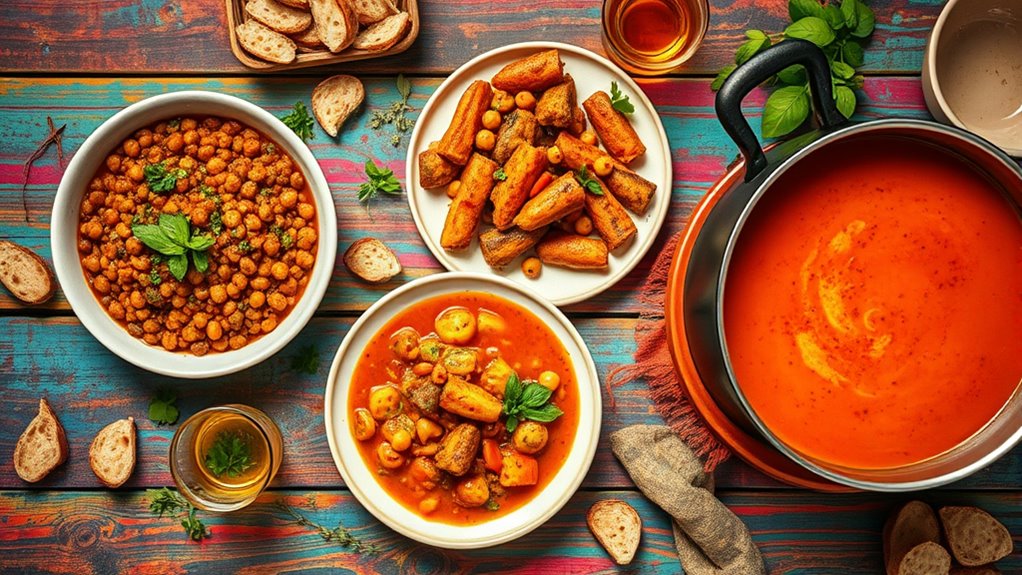
Wholesome Czech soups, stews, and one-pot meals highlight the beauty of slow-cooking techniques that develop rich flavors while keeping dishes healthy and straightforward to prepare. These wholesome soups, like green lentil soup or traditional goulash, use fresh vegetables, lean meats, and regional spices such as paprika and caraway. Incorporating low-light office plants can enhance the ambiance of your kitchen or dining area, creating a more inviting environment. The cycle of breakups can often be mitigated by incorporating comforting, nourishing dishes that promote emotional well-being, making these recipes ideal for soothing post-stress meals. One-pot meals simplify cooking, combining protein, fiber, and vegetables into hearty dishes that are quick to make—most under 60 minutes. These recipes emphasize healthy ingredients, ensuring you enjoy comforting, nourishing meals without sacrificing nutrition. By focusing on regional flavors and traditional methods, you get an authentic taste of Bohemian cuisine that’s both satisfying and easy to prepare. Incorporating predictive modeling can help optimize ingredient choices and cooking times for even better results. This approach makes wholesome soups and stews perfect for busy home cooks seeking nutritious comfort food. Additionally, cultivating a creative practice in your cooking routines can lead to discovering new flavor combinations and techniques, elevating your culinary experience. Understanding fetal development during the second trimester can guide recipe choices to support maternal nutrition and overall health.
Nourishing Breads and Baked Goods With Regional Ingredients
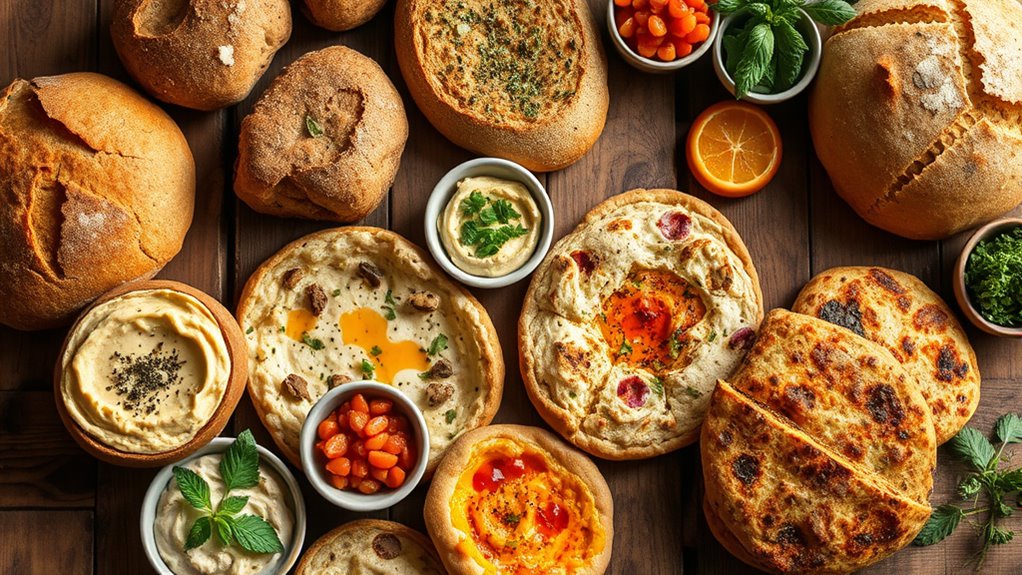
Nourishing breads and baked goods form a cornerstone of Bohemian cuisine, showcasing regional ingredients and traditional techniques. You’ll find that caraway bread, a staple, uses local caraway seeds, flour, and natural leavening like sourdough or yeast, preserving old-world baking methods. Incorporating regional ingredients such as poppy seeds, honey, and marjoram enhances authentic, wholesome flavors. Whole-grain flours and natural leavening support nutrition while honoring cultural practices. Baked goods like kolaches and strudels often feature regional fruits—apples, berries, and plums—highlighting local harvests. These breads and pastries are crafted using simple, time-honored techniques, emphasizing regional grains and seeds. Understanding the importance of traditional baking methods can inspire patience and precision, much like the careful preparation of traditional baked goods. The result is a collection of baked goods that are nourishing, flavorful, and deeply rooted in Bohemia’s culinary heritage.
Fresh, Vibrant Salads and Vegetable-Based Dishes
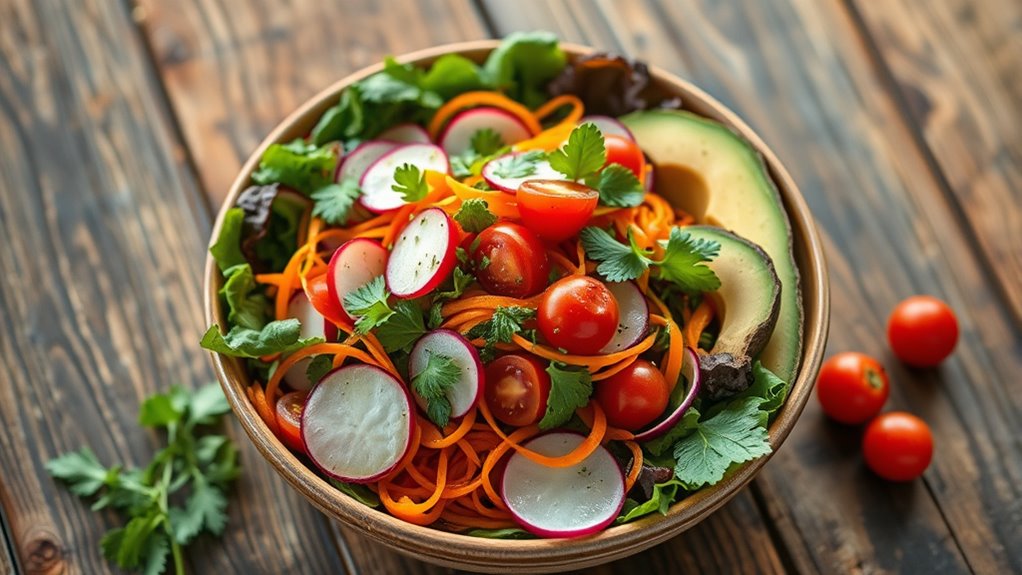
Bohemian cuisine celebrates the vibrant flavors of fresh vegetables and simple preparations that highlight regional produce. You’ll find dishes like chopped salads with quail eggs that showcase seasonal ingredients such as radishes, cucumbers, and fresh greens. Using regional herbs enhances the natural flavors, making each bite lively and authentic. Many vegetable-based dishes are prepared with quick pickling or light sautéing, preserving their crunch and freshness while adding subtle complexity. Salads inspired by Vietnamese cuisine, featuring vermicelli, herbs, and citrus, exemplify how healthy recipes can blend regional influences seamlessly. By focusing on fresh vegetables and regional herbs, these dishes offer nutritious, flavorful options that reflect old-world European culinary traditions, making them perfect for anyone seeking vibrant, wholesome meals.
Sweet Treats and Pastries With Old-World Charm
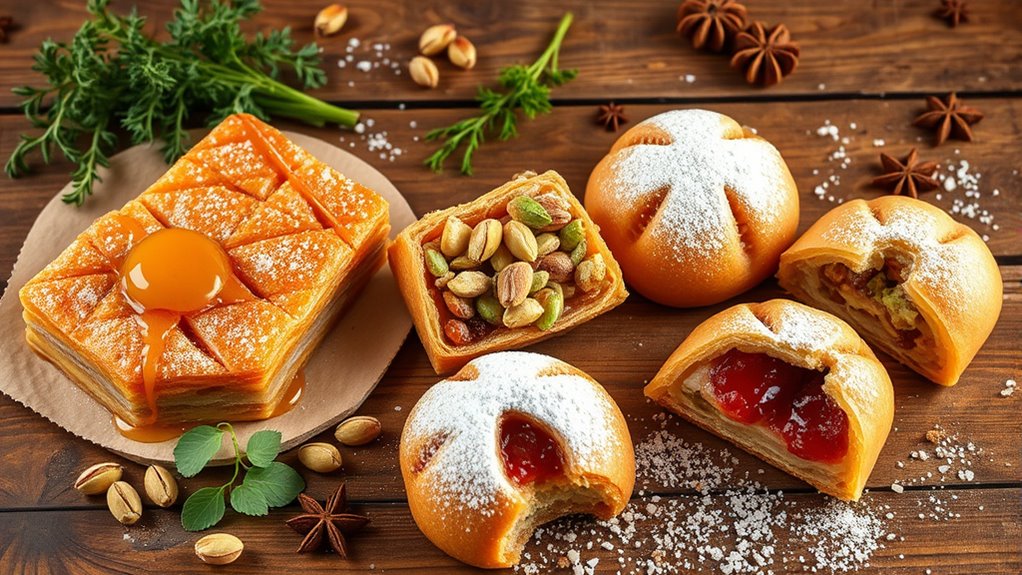
Have you ever tasted a pastry that captures the essence of old-world charm? Traditional Bohemian desserts like kolaches feature fruit fillings such as apricot or plum, nestled in yeasted dough and topped with streusel, reflecting time-honored baking techniques. Classic sweet treats, like marble bundt cakes with vanilla and chocolate swirls, highlight the region’s love for visually appealing, rich flavors. These desserts often incorporate regional ingredients like caraway seeds or poppy seeds, adding distinctive flavors that make each bite special. Many recipes, such as semolina pudding or raspberry jam-filled cookies, are simple yet flavorful comfort foods, perfect for family gatherings and festive occasions. These pastries preserve cultural traditions, offering a taste of old-world charm with every bite. Cultural traditions play a vital role in shaping the unique flavors and presentation of Bohemian desserts, ensuring their legacy endures through generations. Additionally, traditional baking techniques passed down through generations help maintain the authenticity and heritage of these beloved confections. Embracing these regional ingredients can elevate your baking and connect you with centuries-old culinary customs.
Modern Twists on Classic Bohemian Fare
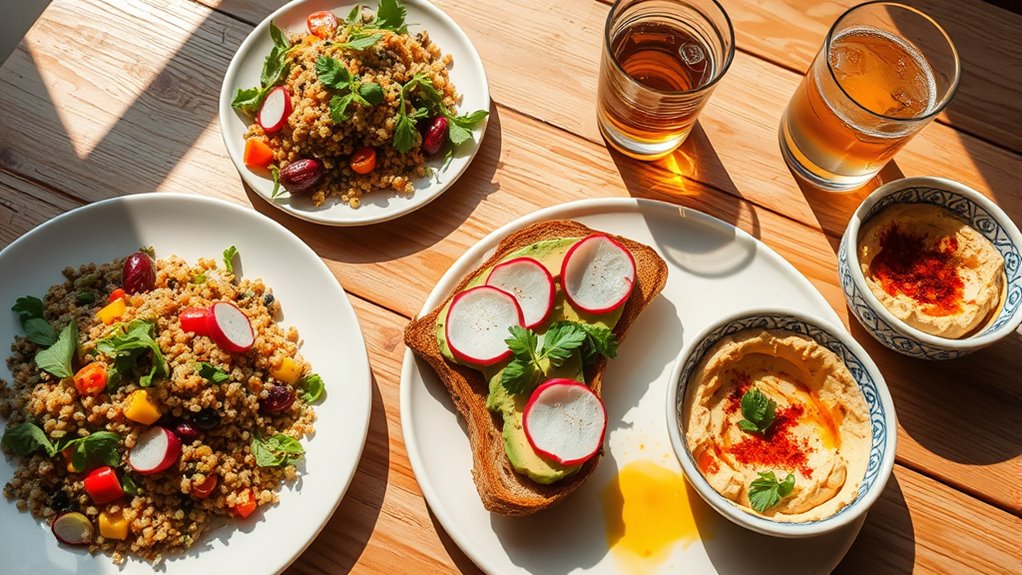
Modern Bohemian dishes often feature creative ingredient substitutions, like quinoa or avocado, to refresh traditional flavors. Chefs also use contemporary presentation styles, such as layered spreads or deconstructed plates, to make the dishes more visually appealing. Additionally, fusion and global influences help bring new textures and flavors to classic recipes, making them both exciting and accessible.
Creative Ingredient Substitutions
By swapping traditional ingredients with inventive alternatives, you can give classic Bohemian dishes a fresh, modern twist without losing their authentic essence. Creative ingredient substitutions allow you to craft healthy recipes that appeal to diverse diets. For example, replace pork or beef with turkey or plant-based proteins to lighten up dishes. Incorporate alternative grains like quinoa or spelt into bread and pastries for extra nutrition and gluten options. Swap traditional paprika with smoked paprika or chili powder to add smoky depth and complexity. Use dairy-free or vegan cream alternatives in desserts like kolaches or crumb cakes to create inclusive, health-conscious treats. Experimenting with regional herbs such as dill, caraway, or thyme can elevate familiar recipes with vibrant, fresh flavors. Exploring different cooking techniques can also enhance the texture and presentation of your dishes, making them more appealing and enjoyable.
Contemporary Presentation Styles
Contemporary presentation styles breathe new life into traditional Bohemian dishes by emphasizing visual appeal and artistic arrangement. Using innovative plating techniques, you can highlight the rustic yet refined qualities of dishes like goulash and kolaches. Vibrant garnishes, such as fresh herbs and edible flowers, add splash and freshness, making each plate enticing. Modern twists often involve plating in unexpected shapes or layered formats, blending old-world charm with contemporary aesthetics. Incorporating artisanal serving ware like wooden boards or ceramic bowls elevates the experience, keeping authenticity alive. Additionally, awareness of support hours can help plan the timing of your culinary exploration and presentation. Paying attention to interior decor can enhance the overall dining atmosphere, creating a cohesive and memorable experience.
Fusion and Global Influences
Fusion and global influences are transforming traditional Bohemian dishes into vibrant, multicultural creations. By blending regional ingredients with international spices and techniques, chefs craft innovative dishes that honor tradition while embracing innovation. You might find goulash reimagined with Mediterranean herbs or kolaches filled with Middle Eastern flavors. Fusion trends include pairing hearty stews with quinoa or adding Asian herbs like cilantro and lime. Global influences also bring superfoods like turmeric and sumac into classic recipes, elevating their flavor and nutritional profile. Chefs creatively incorporate regional ingredients, such as turning Czech bread into European-inspired sushi rolls or infusing Latin flavors into hearty meats. This cross-cultural approach keeps Bohemian cuisine fresh, exciting, and deeply rooted in a rich history of regional ingredients and global influences.
Tips for Creating Healthy, Easy-to-Make Meals Inspired by Czech Heritage
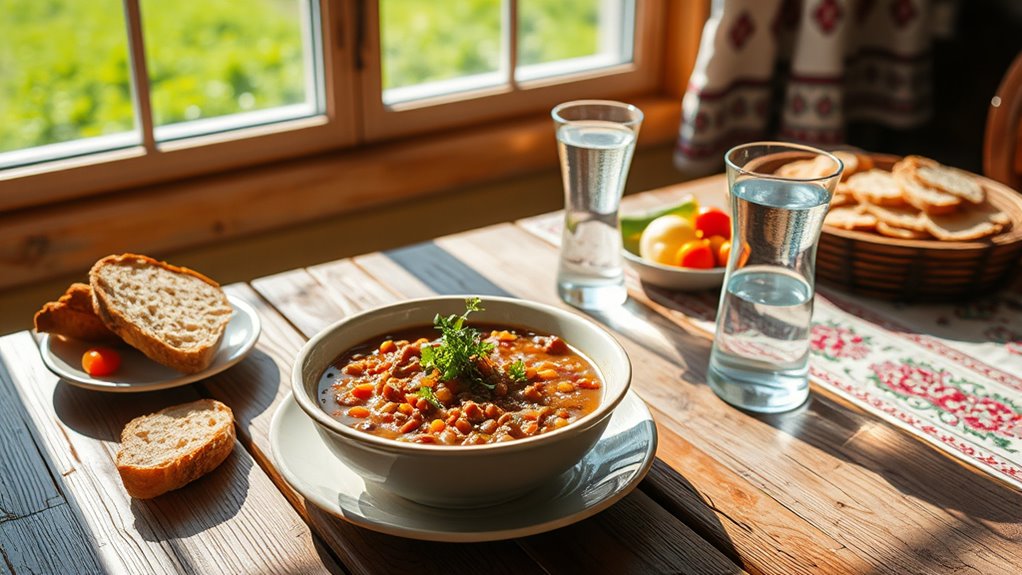
To create healthy, easy-to-make Czech-inspired meals, start by choosing authentic ingredients like paprika, caraway seeds, and fresh herbs to boost flavor without relying on processed additives. Incorporate fresh vegetables such as cabbage, carrots, and potatoes as the base to increase fiber and vitamins in your dishes. As a home cook, focus on simple techniques like slow-cooking meats or baking bread to preserve nutrients and avoid excess fats. Use lean meats like pork or beef, seasoned with paprika rubs or marinades for added flavor without sacrificing healthfulness. Prepare one-pot meals like goulash or lentil stews, which are quick, nutritious, and minimize cleanup. These tips help you craft balanced meals that celebrate Czech heritage while fitting into your busy lifestyle.
Frequently Asked Questions
What Are Some Common Ingredients Used in Authentic Bohemian Cuisine?
You’re curious about common ingredients in authentic bohemian cuisine. Typically, you’ll find hearty grains like rye and barley, fresh vegetables such as cabbage, potatoes, and carrots, and a variety of herbs and spices for flavor. You might also use sourdough bread, pickled vegetables, and smoked meats or fish. These ingredients come together to create rustic, flavorful dishes that reflect the region’s rich culinary traditions and diverse influences.
How Can I Adapt Traditional Recipes for a Vegan or Gluten-Free Diet?
When it comes to adapting traditional recipes, you can think outside the box. Swap animal products for plant-based alternatives like tofu, tempeh, or chickpeas, and use gluten-free grains such as quinoa, rice, or buckwheat. Don’t be afraid to experiment—sometimes you’ll find a new favorite. With a little creativity, you can enjoy your favorite dishes without compromising your dietary needs. After all, where there’s a will, there’s a way.
Are There Any Specific Cooking Techniques Unique to Bohemian Dishes?
You might wonder if bohemian dishes use unique techniques. While they emphasize rustic, improvisational cooking, they often incorporate methods like fermenting, pickling, and slow roasting to develop rich flavors. You’ll find that blending global influences encourages experimentation, so don’t hesitate to try traditional techniques like marinating or using open-flame grilling. These methods help create the vibrant, layered tastes characteristic of bohemian cuisine.
Where Can I Find Regional Ingredients for Authentic Bohemian Recipes?
Imagine wandering through bustling markets filled with colorful spices and fresh produce—that’s where you’ll find authentic ingredients. You can explore local Asian or European grocery stores, specialty markets, or online shops that focus on regional foods. Don’t forget to ask vendors for recommendations; they often know where to find rare items. This journey guarantees your recipes stay true to their cultural roots, bringing vibrant flavors into your kitchen.
How Can I Incorporate Global Spices Without Overpowering Traditional Flavors?
You can incorporate global spices into traditional recipes by starting with small amounts and gradually guarantee to taste. Focus on balancing flavors, so the spices enhance rather than overshadow the core ingredients. Use spices like cumin, coriander, or paprika sparingly, and taste as you go. This approach ensures your dishes retain their authentic essence while gaining a subtle, exciting global twist.
Conclusion
So, there you have it—your passport to Bohemian bliss in a bowl. Who knew hearty Czech classics could get a global glow-up? With these quick, healthy twists, you’ll impress friends, satisfy cravings, and maybe even forget that traditional recipes sometimes come with a side of guilt. So go ahead, get creative, and turn your kitchen into a bohemian bistro—because why settle for boring when you can have bold, beautiful, and oh-so-easy?
